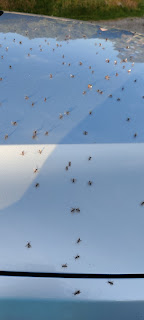This weekend I was helping out at a Grasses workshop and needed to collect samples of different grasses. Many I could find in my garden but for some I needed a different habitat so went up Glen Banchor on a warm Saturday evening. I was not alone. The sky was teeming with flying ants which took an immediate liking to my car bonnet.
The photo does not do justice to their energy so here is a video:
The ants are all males who have developed wings and are in search of the much larger female Queen ant to mate with. Most will be unsuccessful and they all die within a couple of days. The Queen lives on to start a new colony. You can read more about it at the Natural History Museum page here. The warm weather triggers the flying day.
The day after the workshop was much cooler and I went for a walk by the Spey, along the Wildcat Trail. To get there, I walked through Newtonmore Golf Course and a large stand of pink spikes caught my attention.
 |
| Pink Woundwort flowers with Hogweed and Valerian in the background |
There are 3 species of Woundwort locally - Hedge, Marsh and a hybrid between the two and I was trying to remember how to tell the difference. Helpfully, I found all three species on my walk so was able to name this stand as the hybrid,
Stachys x ambigua. This is a cross between Hedge Woundwort (
Stachys sylvatica) and Marsh Woundwort (
Stachys palustris). If an insect visits one of these species and then goes on to visit and pollinate the other species, the seed formed will be of the hybrid and if it lands somewhere and successfully grows, the plants are then the hybrid species. Hybrids are usually quite vigorous and this stand had hundreds on flower spikes. However, it can't produce fertile seed but can spread through its roots. Here is a closer picture of the hybrid:
 |
| Hybrid Woundwort |
And here are the other two Woundworts:
 |
| Left: Marsh Woundwort, Right: Hedge Woundwort |
The obvious differences are with the flower colour and the leaves. Hedge Woundwort has beetroot coloured flowers and wide leaves with a long stalk. The Marsh Woundwort has paler bigger flowers and dark narrow leaves that have no stalks but are joined straight onto the stem (which is called sessile in botany terms). The hybrid features are in between these two extremes so the leaf has a short stem, and is neither narrow or broad and the flower is somewhat between the two colours. The leaves also have a strong rather unpleasant odour, strongest in Hedge Woundwort and least strong in Marsh Woundwort.
 |
| Woundworts left to right: Marsh, Hybrid, Hedge |
 |
| Woundworts left to right: Marsh, Hybrid, Hedge |
Why is the plant called Woundwort? "Wort" means it is used for medicine or food, and indeed it was used to treat wounds, or so Gerard tells us; you can read his chapter on Woundwort
here, from his book published in 1567. It sounds as though he learnt its use from a peasant:
The leaves hereof stamped with Axungia or hog's grease, and applied unto green wounds in manner of a poultice, healeth them in short time, and in such absolute manner, that it is hard for any that have not had the experience thereof to believe: for being in Kent about a patient, it chanced that a poor man in mowing of peas did cut his leg with a scythe, wherein he made a wound to the bones, and withal very large and wide, and also with great effusion of blood; the poor man crept unto this herb, which he bruised with his hands, and tied a great quantity of it unto the wound with a piece of his shirt, which presently stanched the bleeding,
It also seems that there was no such thing as a day off sick!
and ceased the pain, insomuch that the poor man presently went to his day's work again, and so did from day to day, without resting one day until he was perfectly whole, which was accomplished in a few days, by this herb stamped with a little hog's grease, and so laid upon in manner of a poultice, which did as it were glue or solder the lips of the wound together, and heal it according to the first intention, as we term it, that is, without drawing or bringing the wound to suppuration or matter; which was fully performed in seven days, that would have required forty days with balsam itself.





